Museum of the Portuguese Language
The Museum of the Portuguese Language (Portuguese: Museu da Língua Portuguesa, [muˈzew dɐ ˈlĩɡwɐ poɾtuˈɡezɐ], locally [muˈzew da ˈlĩɡwɐ poɾtuˈɡezɐ]) is an interactive Portuguese language—and Linguistics/Language Development in general—museum in São Paulo, Brazil. It is housed in the Estação da Luz railway station, in the urban district of the same name. Three hundred thousand passengers arrive and leave the station every day, and the choice of the building for the launching of the museum is connected to the fact that it was mainly here that thousands of non-Portuguese speaking immigrants arriving from Europe and Asia into São Paulo via the Port of Santos got acquainted with the language for the first time. The idea of a museum-monument to the language was conceived by the São Paulo Secretary of Culture in conjunction with the Roberto Marinho Foundation, at a cost of around 37 million reais.[2]
Museu da Língua Portuguesa | |
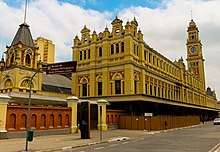 Station with upper floors' museum | |
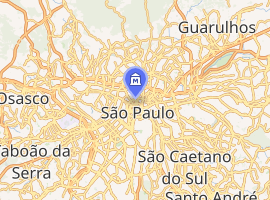
| |
| Established | 20 March 2006 |
|---|---|
| Location | Estação da Luz, São Paulo, Brazil |
| Coordinates | 23°32′6.12″S 46°38′11.82″W |
| Visitors | 580.000[1] (2006) |
| Director | Antonio Sartini |
| Curator | João Manuel Rendeiro |
| Public transit access | |
| Website | museulp.org.br |
The objective of the museum is to create a living representation of the Portuguese language, where visitors may be surprised and educated by unusual and unfamiliar aspects of their own native language. Secondly, the caretakers of the museum, as expressed on the official website, "desire that, in this museum, the public has access to new knowledge and reflection in an intense and pleasurable manner," as it notices the relationship of the language with others, as well as its proto-languages. The museum targets the Portuguese speaking population, made up of peoples from many regions and social backgrounds, but who still have not had the opportunity to gain a broader understanding of the origins, the history and the continuous evolution of the language.
History
Development
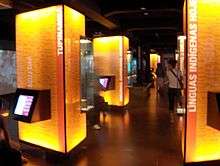
The project was conceived in 2001.[3] It is speculated by many sources that São Paulo was chosen as the site of the museum for its symbolism, as it is the largest Portuguese-speaking city and metropolitan region in the world, with 20 million inhabitants.
Among the partners in the project were Gilberto Gil, IBM Brazil, the Brazilian Postal Service, Rede Globo, Petrobras, Vivo, AES Eletropaulo, Grupo Votorantim and BNDES.[4] Also supporting the effort were the Calouste Gulbenkian Foundation, the Community of Portuguese Language Countries, the mayorship of São Paulo, the CPTM, the Otis Elevator Company, Carrier and the Luso-Brazilian Foundation.[5]
The idea of a Portuguese Language museum came from Ralph Appelbaum, who also developed the United States Holocaust Memorial Museum in Washington D.C., and the fossil room of the American Museum of Natural History in New York City. The architectural project was undertaken by Brazilian father-son duo Paulo and Pedro Mendes da Rocha.[6] The director of the museum is sociologist Isa Grinspun Ferraz, who coordinated a team of thirty Portuguese language specialists to implement the museum. The artistic director is Marcello Dantas.[7]
Opening ceremony
The museum was dedicated on Monday, 20 March 2006, with the presence of the Minister of Culture and singer Gilberto Gil, representing the Brazilian president Luiz Inácio Lula da Silva. Also present were the Minister of Culture of Portugal, Isabel Pires de Lima, the governor of São Paulo, Geraldo Alckmin, former President Fernando Henrique Cardoso, the mayor of Lisbon António Carmona Rodrigues, the Minister of Foreign Affairs of Guinea-Bissau António Isaac Monteiro, the President of the Calouste Gulbenkian Foundation, and other representative authorities from all Portuguese-speaking nations. Gilberto Gil spoke during the ceremony:
The language speaks for you. The purpose of studying and interacting with a language in a museum, cultural and exchange programs, orthographic agreements, and the development of new words show how important it is. The language is our mother. This museum covers most, if not all, the aspects of the written and spoken language, of the dynamic language, the language of interaction, the language of affection, the language of gestures and of any other aspects that this museum was meant to promote.[8]
Sílvia Finguerut, director of Patrimony and the Environment for the Roberto Marinho foundation, claimed that there didn't exist a museum in the world dedicated solely to a language. Finguerut noted the symbolism of the museum's location in the Estação da Luz:
During many decades, the foreign immigrants who were reaching São Paulo were disembarking in this station, a place where other languages were meeting with our Portuguese.[2]
Geraldo Alckmin alluded to the importance of the museum to the Portuguese-speaking community, to the students, the professors, and to the preservation of the language itself.
This shows again the important role of Brazil in the picture of the development of the Portuguese language. It is an extraordinary initiative for the reinforcement of the solidarity between the peoples who speak Portuguese.[8]
José Roberto Marinho finished the ceremony:
It is fundamental that people communicate. It is necessary to know the language to go deeper into several subjects. And in this space we find the means of directing people to the study of, and the interest for the language and also of having an intersection of the academic world with daily life.[8]
The following day, 21 March, the doors of the museum were opened to the public.
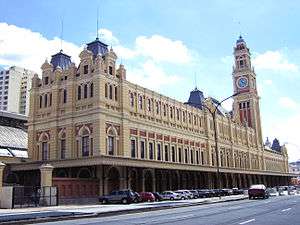 The Estação da Luz, the building housing the museum.
The Estação da Luz, the building housing the museum.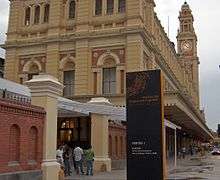 The entrance to the museum.
The entrance to the museum.
Museum
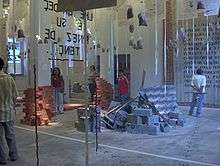
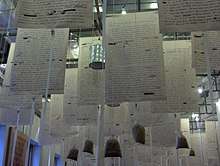
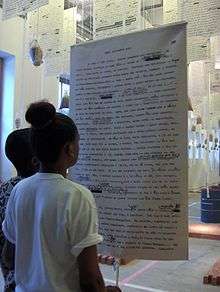
The museum itself features innovative and predominantly virtual exhibits which feature a mixture of art, technology and interactivity, while keeping in mind the historical building the museum is housed in. It consists of diverse exhibitions with hands-on activities, videos, sounds and images about Linguistics and Portuguese language developments.
The museum occupies three floors of the Estação da Luz and is 4,333 m² in area. The entryway to the museum contains the "Tree of the Language", a three-story high sculpture, created by Brazilian architect Rafic Farah. The leaves are outlines of objects and the roots are formed by words that gave rise to those words in Portuguese. The tree can be seen through transparent walls when using the elevator.
The first project of the museum was the "Project of the Formation of Educators", coordinated by the State Secretary of São Paulo and by the Roberto Marinho Foundation. The main goal of this program is the instruction of 4,800 teachers in the areas of the Portuguese language, literature, arts education, geography and history, involving around 300 public schools.[5]
Internal spaces
The museum includes the following rooms and exhibits:
Auditorium
The auditorium contains a large screen, nine meters wide, which plays a short film created by Antônio Risério and directed by Tadeu Jungle. This film covers the rise of human language, its history, diversity, power and importance. The screen reveals a revolving door that leads to the "Plaza of the Language".
Grand gallery
This giant space contains a much larger screen, 106 meters in length, which projects eleven films simultaneously, directed by Marcello Dantas, Victor Lopes and Carlos Nader. Each projection is nine meters wide and six minutes in length, and deals with a specific theme; these include dance, parties, carnivals, football (soccer), music, human relations, food, values, knowledge and Portuguese culture. The screen in the Grand Gallery is considered one of the largest projection screens in the world, at 106 meters wide.
Word alley
In this area, visitors entertain themselves by moving around images containing fragments of words, including prefixes, suffixes and radicals in a game to try to form complete words. When this is done, the table is transformed into a screen that runs an animation about the origin and meaning of the given word. This was designed by Marcelo Tas with the support of etymologist Mário Viaro.
Map of the speakers
This interactive display shows the various dialects throughout Brazil. Visitors can navigate the map and access audio clips from speakers in various states of the Federation.
Crosswords
In this space there are triangular multimedia totems dedicated to the languages that formed and influenced Brazilian Portuguese, including two totems for African languages, two for South American languages, one for Spanish, one for English and French, one for immigrant languages and the last for Portuguese in the world. Each totem has three interactive monitors, one on each face. The objective of these is to show the rich cultural heritage of the language, and the contributions of many different areas the language and the Brazilian identity.
Plaza of the language
Resembling an amphitheatre with terraces, this area is a "planetarium of words", with visual effects that are projected on the ceiling and a lighted floor. The projections include the great classics of prose and poetry in Portuguese along with sounds and images. The images were created by Eduardo Menezes, Guilherme Specht and André Wissenbach, with artistic director Marcello Dantas and the music is produced by Cacá Machado.
The feature includes poems by Carlos Drummond de Andrade, Gregório de Matos, Fernando Pessoa and Luís de Camões, texts by João Guimarães Rosa, Euclides da Cunha and Machado de Assis and songs by Noel Rosa and Vinícius de Moraes. The work was assembled by literature professors and musicians José Miguel Wisnik and Arthur Nestrovski.
The presentation consists of three verses, twenty minutes each. The narrators are Arnaldo Antunes, Bete Coelho, Chico Buarque, Juca de Oliveira, Maria Bethânia, Paulo José and Zélia Duncan among others.
Timeline
On a large panel, the remote Indo-European origins of languages are shown. The history and evolution of Portuguese is traced from Archaic Latin through Classical Latin, Vulgar Latin and old Romance languages to the three elements that make up the heart of contemporary Portuguese: Lusitanian Portuguese, languages indigenous to Brazil and African languages. The panel covers six thousand years of human history and is the product of research by professor Ataliba de Castilho.
A selection of 120 large works of Brazilian literature complement the exhibition of the history of the language.
Temporary exhibitions
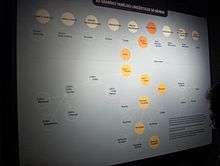
In this area, the temporary exhibits of the museum are displayed. The first exhibit in this space is a tribute to the 50-year anniversary of Grande Sertão: Veredas. This exhibit contains seven paths, each corresponding to a character or important aspect of the book.
See also
- Museum
- Portuguese language
- Lusophony Games
- Estação da Luz
- Instituto Camões
References
- ALFANO, Ana Paula (11 January 2008). Istoé Gente (ed.). "Museu da Língua Portuguesa é o mais visitado".
- "Museu da Língua Portuguesa aberto ao público no dia 20". Notícias Lusofonas. Retrieved 2006-06-29.
- "Museu desperta a importância da língua portuguesa". Revista Museu. 2005-03-21. Archived from the original on 2007-09-28. Retrieved 2006-06-29.
- "Museu da Língua Portuguesa será inaugurado em SP". Revista Museu. 2005-04-16. Archived from the original on 2007-09-28. Retrieved 2006-06-29.
- "Museu da Língua Portuguesa inaugurado em São Paulo". Jornal de São Tomé. 2006-03-21. Archived from the original on 2007-09-28. Retrieved 2006-06-29.
- "Estação histórica abre espaço para acervo virtual da língua". Exhibição de Notícias. Centro Brasileiro da Construção em Aço. Retrieved 2006-06-29.
- "Museu da Língua Portuguesa é inaugurado hoje em São Paulo". Diário de Notícias. 2006-03-06. Archived from the original on 2007-07-08. Retrieved 2006-06-29.
- "Ministro da Guiné Bissau destaca importância do Brasil". O Globo. 2006-03-21. Archived from the original on 2006-05-19. Retrieved 2006-06-29.
- "Brazil: Fire engulfs Portuguese language museum in Sao Paulo, one killed"
- "Fogo na centenária estação da Luz destrói museu e mata funcionário"
External links
| Wikimedia Commons has media related to Museu da Língua Portuguesa. |
| Wikiquote has quotations related to: Museum of the Portuguese Language |
- Official website (in Portuguese)
![]()